Road Marking Paint and Machine Manufacturer
+86-15668659958
Road Marking Paint and Machine Manufacturer
+86-15668659958
Q: Can the fluidity of C5 petroleum resin be further improved?
Answer: Yes, it is possible
How to reduce the melt viscosity and improve the melt flowability of C5 petroleum resin? See below:
Type: Polyether modified polydimethylsiloxane Main function: significantly reduces melt viscosity: improves flowability by reducing frictional resistance inside the resin melt and between the melt and processing equipment, making the resin easier to spread and level. Improve melt flowability: Effectively reduce surface tension, promote better wetting of the substrate or self spreading of the resin in the molten state, and reduce defects such as sagging and orange peel. Possible assistance in reducing softening point: Although leveling agents themselves do not directly change the molecular structure of the resin, by improving the lubricity and mobility of the molecular chains, they may help the resin to begin softening flow at lower temperatures (manifested as a slight decrease in apparent softening point) and increase the processing window. Improve surface smoothness and scratch resistance.

Advantages: It usually has good compatibility with C5 petroleum resin (non-polar to weakly polar). Efficient, with low dosage (usually between 0.05% and 0.3%).
While improving liquidity, it can also provide excellent surface effects.
Application areas: Widely used in coatings, inks, adhesives, hot melt adhesives, etc., with good effects on petroleum resin systems. 🔍 Other alternative products to consider TEGO ® Flow 300 / TEGO ® Glide 410 (Evonik): also belongs to the polyether modified siloxane leveling agent category. Provide excellent flow, leveling, and substrate wetting properties. It can also effectively reduce viscosity and improve melt flowability. The specific model selection can be adjusted according to subtle requirements such as smoothness and recoating ability. Dow Corning ® (Dow Corning) DC 51, DC 56, DC 57: Dow Corning’s series of organic silicon surfactants/leveling agents. These polyether modified siloxanes can also effectively reduce surface tension, improve flow leveling, and reduce internal friction. When choosing, attention should be paid to the compatibility with the specific grade of C5 resin. Hydropalat ® WE 3110/WE 3111 (Clariant): Clariant’s wetting dispersant/leveling agent may also be applicable to some silicone modified polyether products. Specific product technical information needs to be consulted to confirm its effectiveness in reducing melt viscosity and improving flowability.

Important advice and precautions: Compatibility testing is crucial: The specific composition (such as molecular weight distribution and polar group content) of C5 petroleum resin from different manufacturers and grades may vary. Be sure to conduct a small test after selecting the leveling agent to confirm its good compatibility (no turbidity, precipitation, or fogging) in your specific resin and achieve the expected effect. Excessive use or poor compatibility of silicone leveling agents may lead to side effects such as shrinkage and oil pockets. Optimization of addition amount: The leveling agent has a non-linear effect and there is an optimal range of addition amount. Too low an effect may not be significant, while too high an effect may lead to side effects such as excessive smoothness affecting adhesion and increased risk of shrinkage.
The optimal addition amount needs to be determined through experiments. The effect of processing temperature on improving melt flowability is closely related to the processing temperature. Ensure that the testing is conducted at the processing temperature you are actually using. The understanding of “reducing softening point”: Leveling agents mainly improve the flowability of resins above the softening point through lubrication, and usually do not significantly change the chemical structure and intrinsic softening point of the resin (measured by the global method). It mainly makes the resin flow more easily after reaching the softening point, or appear softer and easier to process near the softening point (i.e., with better apparent flowability). If you need to substantially reduce the softening point, you may need to consider adjusting the resin formulation itself, but this may sacrifice other properties such as cohesive strength and heat resistance. Leveling agents are a better choice for achieving “fluidity improvement”.
Supplier consultation: Contact the technical support department of TOP ROAD supplier directly and provide your C5 resin grade (if possible) and specific application (such as for hot melt adhesive, pressure-sensitive adhesive, road marking paint, etc.). They will recommend the most suitable product model based on your specific needs. 📌 To summarize the requirements for reducing viscosity, improving melt flowability, and enhancing processing leveling of C5 petroleum resin, polyether modified silicone leveling agents (such as BYK-333, TEGO Glide 410, DC 51, etc.) are the preferred solution. They can efficiently meet your first two core needs by reducing surface tension and internal friction, and may improve the performance of the resin near the softening point to some extent. Please conduct small-scale compatibility and effectiveness testing to confirm the optimal product and dosage. At the same time, clarify whether the specific expectation of “reducing softening point” is an essential decrease or an improvement in liquidity. Wishing you the most suitable solution!
Our company is a professional manufacturer of road hot-melt coatings and road glass beads. If you are interested, please feel free to contact me via email at any time export@toproadtraffic.com
